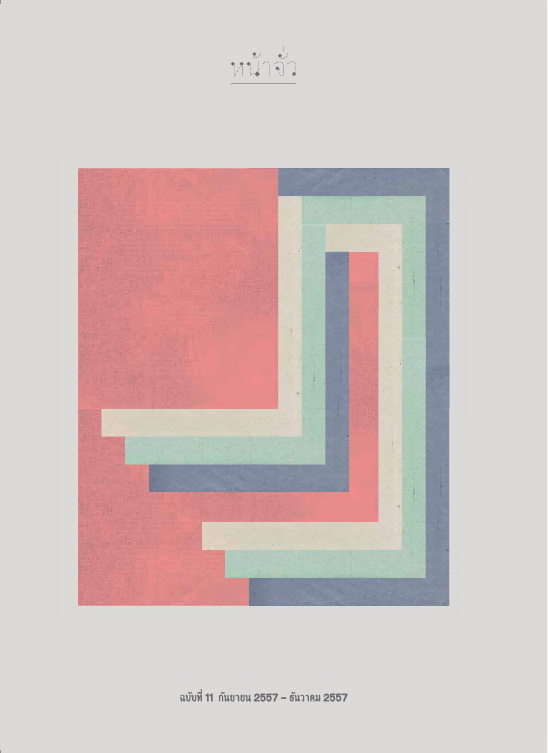แนวทางการสันนิษฐานรูปแบบเจดีย์วัดอาวาสใหญ่ กำแพงเพชร/ A Reconstruction of the Stupa at Wat Avas Yai, Kamphaeng Phet
Main Article Content
Abstract
บทคัดย่อ
บทความ “แนวทางการสันนิษฐานรูปแบบเจดีย์วัดอาวาสใหญ่ กำแพงเพชร” เป็นส่วนหนึ่งของการทำวิทยานิพนธ์ในหัวข้อ “รูปแบบเจดีย์กำแพงเพชร : กรณีศึกษาวัดอาวาสใหญ่ กำแพงเพชร” ที่มุ่งศึกษาหาแนวทางการสันนิษฐานรูปแบบเจดีย์วัดอาวาสใหญ่ โดยวิเคราะห์จากสิ่งก่อสร้างที่เหลือของเจดีย์ประธาน คือฐานล่างสุดที่ทำเป็นฐานเขียงแปดเหลี่ยมยืดสูงแล้วต่อด้วยฐานบัวย่อมุมไม้ยี่สิบ ผลการศึกษาพบว่าเจดีย์ประธานมีลักษณะเฉพาะ สามารถสันนิษฐานถึงรูปแบบได้ 2 แนวทาง โดยแนวทางแรกสันนิษฐานว่าเป็นเจดีย์ทรงระฆังฐานแปดเหลี่ยมที่พบในกำแพงเพชร แบ่งออกเป็นรูปแบบที่ได้รับอิทธิพลของล้านนา ราวปลายพุทธศตวรรษที่ 20 ถึงต้นพุทธศตวรรษที่ 21 กับในช่วงที่รับอิทธิพลอยุธยา คือราวกลางพุทธศตวรรษที่ 21 ส่วนแนวทางที่ 2 เป็นรูปแบบที่คล้ายกับวัดศรีพิจิตรกีรติกัลยาราม สุโขทัย เนื่องจากข้อความที่ปรากฏในศิลาจารึกได้มีการอัญเชิญพระภิกษุจากกำแพงเพชรไปสร้างวัดพระศรีพิจิตรกีรติกัลยารามที่สุโขทัย และทางด้านรูปแบบทั้งสองวัดมีการทำฐานล่างคล้ายกัน คือฐานบัวไม้ยี่สิบยืดท้องไม้สูง นอกจากเจดีย์ประธานแล้วเจดีย์รายวัดอาวาสใหญ่ยังปรากฏความน่าสนใจทางด้านรูปแบบและตำแหน่งที่ตั้งอีกด้วย โดยแสดงให้เห็นถึงการรับแนวคิดการสร้างรูปแบบใหม่ซึ่งเป็นรูปแบบที่ได้รับอิทธิพลจากศิลปะอยุธยานอกจากนี้ที่กำแพงเพชรยังนิยมทำเจดีย์ที่มีการผสมผสานหลายๆ ศิลปะเข้าด้วยกัน สอดคล้องกับเรื่องราวทางประวัติศาสตร์เมืองกำแพงเพชรที่เป็นเมืองทางผ่านให้กับอาณาจักรสำคัญทั้งสุโขทัย ล้านนา และอยุธยา จึงทำให้เกิดรับรูปแบบศิลปกรรมของทั้ง 3 เมือง และสามารถนำมาปรับเปลี่ยนให้เกิดเป็นรูปแบบเฉพาะของตนเอง ตัวอย่างที่เห็นได้ชัดคือการทำรูปแบบเจดีย์ทรงระฆังฐานแปดเหลี่ยม และจากการทำการศึกษารูปแบบเจดีย์ทรงระฆังฐานแปดเหลี่ยมทั้งหมดในกำแพงเพชร พบว่าในระยะแรกมีรูปแบบใกล้เคียงเจดีย์แปดเหลี่ยมสุพรรณบุรี-สรรค์บุรี ในช่วงระยะกลางรูปแบบเจดีย์จะมีลักษณะเด่นอยู่ที่การทำฐานบัวแปดเหลี่ยม 1 ชั้น คาดด้วยลูกแก้วอกไก่ 1 เส้น และมีองค์ระฆังที่ใหญ่ที่ได้รับรูปแบบจากศิลปะสุโขทัย ซึ่งภายหลังทำฐานบัวแปดเหลี่ยมซ้อนเพิ่มเป็น 2 ชั้น องค์ระฆังจึงเล็กลง โดยในช่วงนี้มีการรับรูปแบบศิลปะล้านนาเข้ามา จนกระทั่งในระยะปลาย เจดีย์พัฒนาไปเป็น การทำฐานบัวถึง 3 ชั้น ทำให้มีองค์ระฆังเล็กมาก และมีการนำบัวลูกฟักที่มีอิทธิพลศิลปะอยุธยาเข้ามาใช้
Abstract
This article is drawn out of my thesis entitled “Stupas in Kamphaeng Phet : A Case Study of Wat AvasYai.” The temple was chosen as a case study since the main stupa in the monastic compound had unique characteristics and can be related to other stupas in Kamphaeng Phet area. This paper aims to study the remains of this main stupa, whose octagonal and square bases with indented corners evidently survive.
The study suggests two speculative models of the principle stupa. First, it has octagonal and square bases with indented corners surmounted by another octagonal base and a bell-shaped body; and second, the same bases is surmounted by a square base with indented corners and a bell-shaped body. The first model can be divided into another two types : one with Lanna influence during the 14th to 15th centuries ; and the other with influence of Ayutthaya at the beginning of 16th century. While the second model was parallel to the main stupa at Wat Sri Phichit Kirati Lalayaram, Sukhothai. According to ancient inscription, a senior monk from Kamphaeng Phet was invited to oversee the construction. The main stupa at Wat Avas Yai also had minor stupas to the east, which were under the influence of Ayutthaya. Stupas at other monastic compounds in Kamphaeng Phet contained influence from those of Sukhothai, Lanna, and Ayutthaya which were adapted and transformed into local style, such as a bell-shaped body with an octagonal base. The stupas with these mixed influences reflected the influences of the three Kingdoms over Kamphaeng Phet.
Bell-shaped stupas with an octagonal base in Kamphaeng Phet can be divided into three periods : Of the first period, they are similar to octagonal type stupas built in central Thailand during the 14th century. The octagonal base was adorned with lotus moulding and surmounted by a large bell-shaped body with Sukhothai influence. Bell-shaped stupas of the second period are under Lanna influence ; their octagonal bases had two tiers and were surmounted by a bell-shaped body whose size was smaller than that of the first period. The third period type had the smallest bell-shaped body with three-tier lotus base influenced from Ayutthaya.

